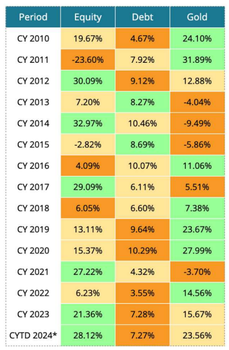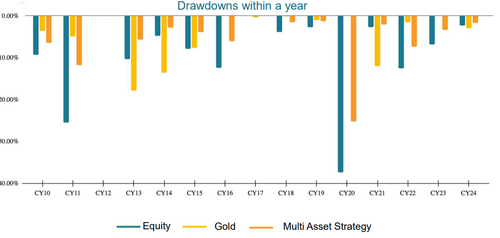Publish Date:
At a time when the markets have scaled a lifetime high, and there are chances of some correction owing to the valuation premium Indian equities command, and other risk factors in play such as geopolitical tensions, chances of economic fragmentation, risk to the inflation trajectory, fear that the U.S. may slip into a recession (due to a potential hard landing), among many others, Union Mutual Fund has opportunely come up with the New Fund Offer (NFO) of Union Multi Asset Allocation Fund (open for subscription from August 20, 2024, to September 3, 2024).
It is an actively managed open-ended hybrid scheme tactically investing in equity, debt, gold and/or silver, as well as units of REITs and InvITs.
Under normal circumstances, around 65% to 80% of its total assets will be invested in equity & equity-related instruments, including derivatives. But the scheme shall stay away from investing in foreign/overseas securities.
The derivative positions may be up to 50% of the net assets of the Scheme for hedging and other than hedging purposes, of which, the exposure for other than hedging purposes shall be capped at a maximum of 20% of the net assets of the Scheme. That scheme shall not do the writing of the covered call option. Likewise, the Scheme shall not indulge in short-selling.
Further, within the aforesaid limit of 50% exposure to derivatives, the exposure to debt derivatives shall be capped at 15% of the net assets of the Scheme. However, it will not indulge in Credit Default Swaps (CDS).
Around 10% to 25% of the total assets would be invested in debt and money market instruments, including units of debt-oriented mutual fund schemes.
The debt-oriented mutual fund schemes could be that of Union Asset Management Company or in schemes of any other mutual funds.
Under its debt portion, Union Multi Asset Allocation Fund may also invest in AT1 and AT2 bonds (debt instruments with special features)
The Scheme may also take a maximum exposure of 20% of its net assets to securities lending. However, debt securities having structured obligations, i.e. SO/CE rating would not be a part of the portfolio.
TREPs or Treasury Bills Repurchases may be up to 20% of the net assets of the Scheme. That being said, the exposure to TREPS may exceed the limit specified at the time of building up the portfolio of the Scheme post-NFO period and also pending deployment of new inflows received in the Scheme on an ongoing basis.
The Scheme shall not invest in repo/reverse repo transactions of corporate debt securities.
Around 10% to 25% of the total assets of Union Multi Asset Allocation Fund would invest in gold ETFs, and up to 10% in silver ETFs.
The investment in units of REIT and InvITs would be 10% of the asset of the Scheme.
What is the Investment Objective?
The investment objective of the Scheme is to generate long-term capital appreciation by investing in a diversified portfolio of Equity and Equity Related Instruments, Debt and Money Market Instruments, units of Gold Exchange Traded Funds (ETFs) and/or Silver ETFs and units of REITs & InvITs as per the asset allocation pattern of the Scheme.
However, there is no assurance or guarantee that the investment objective of the Scheme will be achieved.
Simply, by investing in multi assets (in a tactical manner) the Scheme seeks long-term wealth creation.
What is the Investment Strategy?
Union Multi Asset Allocation Fund will follow an active investment strategy and shall invest across asset classes, in line with the asset allocation mentioned with the aim of generating long-term capital appreciation for investors.
The percentage of investment to multiple assets, viz. equity, debt, gold, silver, and units of REITs and InvITs will be decided considering the prevailing market conditions, the macroeconomic environment (including interest rates and inflation), the performance of the corporate sector, the equity markets and general liquidity and other considerations in the economy and markets.
Moreover, based on the fund manager's view and prevailing market conditions, the asset allocation may remain static or dynamic within the permissible limits.
For portfolio construction, the fund manager shall follow a combination of the bottom-up and top-down approach.
The top-down approach shall involve analysis of the macro-economic factors, industry evaluation, benchmark industry allocation, market outlook etc. and shall be used to determine the asset allocation. The investment team shall also scan the market for opportunities and evaluate the individual companies on their merits, leading to the bottom-up investment decision.
The Scheme is expected to invest in a portfolio of carefully selected stocks, offering attractive potential growth opportunities.
Similarly, investment in debt securities will be guided by credit quality, liquidity, interest rates and their outlook.
Investment in units of Gold and/or Silver ETFs is considered to provide a diversification of risk away from equity and fixed income as well as a hedge against inflation for investors.
As regards investment in units of REITs and InvITs and such other securities as specified is concerned, the fund manager has the discretion within the stipulated limits and by adhering to various norms and regulations.
Speaking of derivatives, the Scheme could use it within the permissible limit for hedging and rebalancing the portfolio or such other purpose as may be permitted under the regulations from time to time.
As stated earlier, the Scheme does not intend to invest in overseas/foreign securities participate in repo/ reverse repo transactions in corporate debt securities or engage in short selling or participate in CDS transactions.
The AMC reserves the right to continuously churn the portfolio of the Scheme to achieve the investment objective.
The portfolio of the Scheme will be managed taking into account the associated risks perceived/expected so as to minimise risks by using appropriate risk management techniques. All of these could increase portfolio turnover.
That being said, the fund manager will endeavour to optimise portfolio turnover to maximise gains and minimise risks keeping in mind the costs associated with it. But it is difficult to estimate with a reasonable measure of accuracy, the likely turnover in the portfolio of the scheme. The scheme has no specific target relating to portfolio turnover.
As per AMFI Tier I benchmark and the framework laid down for the composition of the benchmark of Multi Asset Allocation Fund, the Scheme will benchmark with 65% Nifty 50 TRI + 20% Crisil Short Term Bond Fund Index + 15% Domestic price of Gold.
Here's what Mr Harshad Patwardhan, CIO of Union AMC said on the launch of Union Multi Asset Allocation Fund:
"As professional money managers looking to generate consistent performance, it is crucial to embrace the cyclical nature of markets and treat the long term as a series of shorter terms. Adjusting portfolio positioning by 'where we are in the cycle' helps reduce opportunity costs and optimize returns."
Who Will Manage the Union Multi Asset Allocation Fund?
The Scheme will be managed by co-managed by Mr Hardick Bora, Mr Sanjay Bembalkar, and Mr Anindya Sarkar.
Mr Hardick Bora, the present Co-Head of Equity at Union Asset Management Company, holds over 15 years of experience in the financial services sector.
Before joining Union AMC, Hardick served Motilal Oswal Securities Ltd. as Sr. Manager - Institutional Research.
Hardick has a bachelor's degree in Banking and Insurance (BBI) from the University of Mumbai and is a CFA® charterholder with the CFA Institute, USA.
Mr Mr Sanjay Bembalkar is also the Co-Head of Equity at Union AMC and has over 15 years of experience in the field of Equity Research and Fund Management.
Before joining Union AMC in June 2021, Sanjay worked with Canara Robeco Asset Management Company Limited as Fund Manager - Equities.
He is a post-graduate in accounting and finance, a Chartered Accountant, as well as CFA® charterholder with the CFA Institute, USA
Both Hardick and Sanjay, manage various equity-oriented and solution-oriented schemes at Union Mutual Fund.
Anindya Sarkar is the Fund Manager - Fixed Income at Union Asset Management Company Private Limited.
Anindya has an overall experience of over 20 years in the Financial Service Sector. He is a civil engineering graduate (BE - Civil), holds an MBA (Finance), an MBA (Risk & Insurance) and has an FRM certification.
At Union Mutual Fund Anindya is the co-fund manager of Union Corporate Bond Fund, Union Medium Duration Fund, Union Gilt Fund and Union Fixed Maturity Plan-Series 13.
How much is the Minimum Investment in the Union Multi Asset Allocation Fund?
During the NFO period, i.e. from August 20, 2024, to September 3, 2024, the minimum lump sum investment in the Scheme is Rs 1,000/- and in multiples of Re 1/- thereafter.
In the case of switch-in transactions, the minimum investment is Rs 1,000/- or the balance in the account of the unitholder, whichever is lower.
In the case of SIPs during the NFO period, the minimum instalment is as under:
-
Rs 100 and in multiples of Re 1 thereafter for daily frequency
-
Rs 500 and in multiples of Re 1 thereafter for weekly frequency
-
Rs 500 and in multiples of Re 1 thereafter for fortnightly frequency
-
Rs 500 and in multiples of Re 1 thereafter for monthly frequency
Both, the Direct Plan and Regular Plan for available for investments.
After the NFO period, the scheme will re-open for subscription within 5 business days from the date of allotment.
Who Should Consider Investing in Union Multi Asset Allocation Fund?
Investors seeking long-term wealth creation by tactically allocating to equity, debt, gold, silver and units of REITs and InvITs while having a very high-risk appetite may consider Union Multi Asset Allocation Fund. With diversification to these asset classes, the risk would be reduced, and the returns may be optimised.
Table: CY Returns of Asset Classes
 *Data till June 2024.
*Data till June 2024.
Point-to-point returns for a given calendar year. Equity - Nifty 50 Index TRI; Debt - Crisil Short Term Bond Index; Gold -Domestic Prices of
Gold (MCX India Gold Spot Index - 10gms). Past performance may or may not be sustained in the future.
(Source: Bloomberg and AMFI India, as presented in the investor presentation of Union Mutual Fund)
As seen above, no single asset class has consistently outperformed. Over the last two decades, equity, debt and gold have outperformed each other at different times.
This is the basis for why following a tactical multi-asset approach (with a mutual fund) is beneficial.
Graph: A Mult Asset Strategy Helps Minimise the Drawdowns
 Note: Debt was not considered for the above graph, as there were no significant drawdowns for debt in the given period.
Note: Debt was not considered for the above graph, as there were no significant drawdowns for debt in the given period.
Data from 1st January 2010 till 28th June 2024 was considered for 3 years and 5 Years Rolling Returns with daily frequency. Multi asset
strategy considers the theoretical allocation of 65% Nifty + 20% Crisil Short Term Bond Index + 15% Domestic Prices of Gold and the same
in accordance with the scheme benchmark. Data refers to the maximum drawdown during a year if invested at the start of the calendar
year. Past performance may or may not be sustained in the future.
(Source: Bloomberg and AMFI India, as presented in the investor presentation of Union Mutual Fund)
The graph above shows that a multi-asset strategy witnessed lower drawdowns versus solely investing in equity and gold.
Union Mutual Fund as a fund house overall follows robust investment processes and systems, keeping investors' interest at the core of decision-making.
To know more about the Union Multi Asset Allocation Fund, read the Scheme Information Document and Key Information Memorandum.
[Read: Why Investing in Multi-Asset Allocation Funds Makes Sense Now]
Happy Investing!